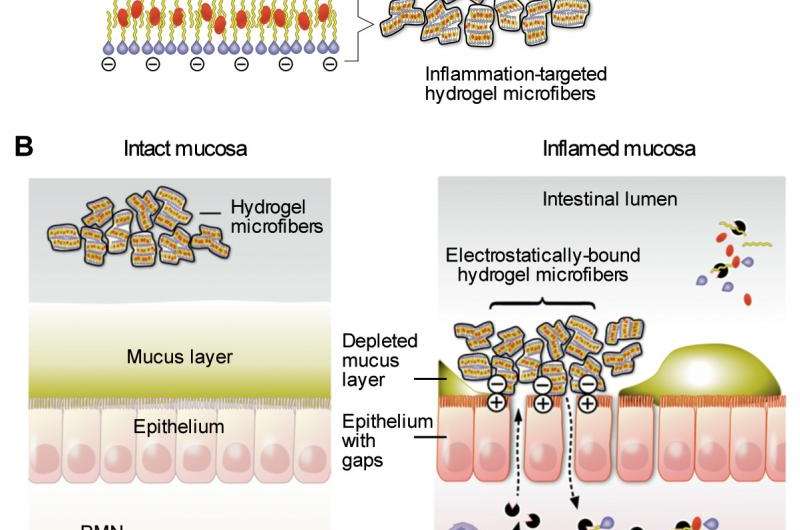Developing a targeted hydrogel to treat inflammatory bowel disease

In the United States, more than 1 million people suffer from inflammatory bowel disease (IBD), and its incidence around the world continues to rise. But treatment delivery options for patients remain limited: many people must rely on daily enemas, which can be uncomfortable, impractical and lead to side effects when medicine is absorbed by healthy tissue. Investigators from Brigham and Women's Hospital (BWH) and collaborators from Massachusetts General Hospital (MGH) and MIT set out to find a better way to deliver medicine using a gel-like material created in the lab. The team, brought together by Harvard Institute of Translational Immunology Pilot Grants in Crohn's Disease from The Leona M. and Harry B. Helmsley Charitable Trust, reports in Science Translational Medicine this week that their hydrogel material was able to stick to sites of inflammation and slowly deliver medicine over time, a breakthrough that has the potential to offer a more targeted enema-based therapy for patients in the future.
"We realized that if we could develop a disease-targeted hydrogel system that rapidly attaches to ulcers and slowly release drugs at the site of inflammation, then we could create a better way to deliver medicine only where the drug is needed," said co-corresponding author Jeff Karp, PhD, of the BWH Department of Medicine and a principal investigator at Harvard Stem Cell Institute. "We're hopeful that this technology will allow patients to take an enema once a week rather than every day and without systemic side effects or the need to retain the enema as the gel quickly attaches to ulcers, ultimately improving their quality of life."
"Maximizing treatment of first line topical therapies for IBD and simultaneously minimizing the potential for side effects from these drugs is an extremely appealing option to both patients and health care providers given the significant risks associated with escalation of therapy which often include drugs which depress the immune system," said co-corresponding author Giovanni Traverso, MD, PhD from the Division of Gastroenterology at the MGH.
The team began their work by selecting a material already approved by the FDA. They chose ascorbyl plamitate (AP), a negatively charged material that would automatically be attracted to positively charged sites of tissue damage, allowing the gel to anchor to these sites. The team then loaded the gel with a corticosteroid drug routinely used to treat IBD.
"The materials we selected form a gel, which has the capacity to carry drugs. We designed the gel to both target inflamed tissue or ulcers and release drug only at sites of inflammation," said co-first author Sufeng Zhang, PhD, a postdoctoral fellow at the David H. Koch Institute for Integrative Cancer Research at MIT.
The team engineered the inflammation-targeting (IT) hydrogel to contain sites that can be cut by enzymes found only where inflamed tissue is present. With a snip from the enzyme, the molecules that make up the gel breaks apart and the gel begins to disassemble, slowly releasing medicine.
The team tested the corticosteroid-loaded IT hydrogel's abilities in two preclinical models of IBD, finding a significant reduction in inflammation with less frequent dosing when compared to traditional corticosteroid-containing enemas. The team also found 5-10 times lower corticosteroid concentrations in the bloodstream, indicating less drug exposure throughout the body.
In addition to studies in preclinical models, the team also tested the gel in colon tissue samples from patients with IBD. They found that the hydrogel preferentially adhered to inflamed lesions rather than to normal tissue. The team plans to repeat their studies using other classes of drugs and test the gel in additional preclinical models before the approach can be tested in patients.
Joerg Ermann, MD, a rheumatologist at BWH and co-first author said, "Our study provides a good example of how therapies can be improved by exploiting disease-specific features for optimal drug delivery. We have found that the hydrogel approach works well in mice and our data look promising that it might also be an effective strategy in humans with inflammatory bowel disease of the colon."
More information: An Inflammation-targeting hydrogel for local drug delivery in inflammatory bowel disease, Science Translational Medicine, stm.sciencemag.org/lookup/doi/ … scitranslmed.aaa5657




















